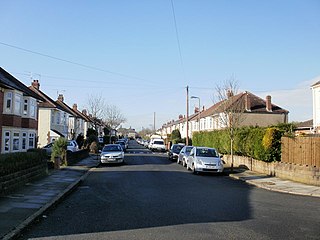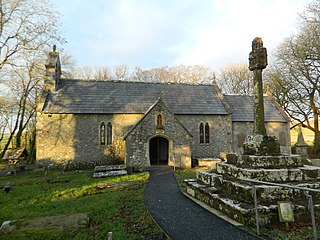Related Research Articles

Lisvane is an affluent community in the north of Cardiff, the capital of Wales, located 5 miles (8 km) north of the city centre. Lisvane is generally considered to be one of the wealthiest residential areas of Wales, with an average house price of £535,770 as of 2020, with many properties worth in excess of £1 million. Lisvane has 3,319 residents, and comprises approximately 1,700 dwellings, a local village shop, a primary school, a community cabin library, a park, a nursery, a parish church, a public house, a war memorial, a Scout hall and community or village hall.

The River Taff is a river in Wales. It rises as two rivers in the Brecon Beacons; the Taf Fechan and the Taf Fawr before becoming one just north of Merthyr Tydfil. Its confluence with the River Severn estuary is in Cardiff.

Dyffryn Gardens is a collection of botanical gardens located near the villages of Dyffryn and St. Nicholas in the Vale of Glamorgan, Wales. The gardens were selected by the British Tourist Authority as one of the Top 100 gardens in the UK and are in the care of the National Trust.

Sir William Goscombe John was a prolific Welsh sculptor known for his many public memorials.

Kinmel Hall is a mansion near the village of St. George, close to the coastal town of Abergele, in Conwy county borough, Wales.
The Vale of Glamorgan has 740 listed buildings of which 4% are Grade I listed, 10% Grade II* listed and remainder Grade II listed.

There are around 1,000 listed buildings in Cardiff, the capital city of Wales. A listed building is one considered to be of special architectural, historical or cultural significance, which is protected from being demolished, extended or altered, unless special permission is granted by the relevant planning authorities. The Welsh Government makes decisions on individual cases, taking advice from the heritage agency Cadw, the Royal Commission on the Ancient and Historical Monuments of Wales and local councils.

Monmouthshire is a county and principal area of Wales. It borders Torfaen and Newport to the west; Herefordshire and Gloucestershire to the east; and Powys to the north. The largest town is Abergavenny, with the other major towns being Chepstow, Monmouth, and Usk. The county is 850 km2 in extent, with a population of 93,600 as of 2019. The present county was formed under the Local Government (Wales) Act 1994, and comprises some sixty percent of the historic county. Between 1974 and 1996, the county was known by the ancient title of Gwent, recalling the medieval Welsh kingdom. In his essay on local government in the fifth and final volume of the Gwent County History, Robert McCloy suggests that the governance of "no county in the United Kingdom in the twentieth century was so transformed as that of Monmouthshire".

Thomas Alwyn Lloyd, known as T. Alwyn Lloyd, was a leading Welsh architect and town planner. He was one of the founders of the Town Planning Institute in 1914 and its President in 1933. He was also a founding member of the Council for the Protection of Rural Wales in 1928 and served as its chairman from 1947 to 1959. Meic Stephens described Lloyd's work as follows:
Lloyd's small-scale buildings reflected his deep feeling for place, in both historical and environmental terms, as in the Garden Villages for which he was responsible in various parts of Wales.

The Golden Cross is a Grade II listed public house at the junction of Customhouse Street and Hayes Bridge Road in the centre of Cardiff, Wales. The current building dates from 1903 and is noted for its distinctive ceramic tiling.

St Canna Church is a church in Llangan, in the Vale of Glamorgan, south Wales. Its churchyard cross is a Grade I listed building, listed on 22 July 2003.

Jackson Hall is a Grade II listed building on Westgate Street, in central Cardiff. It was designed by John Prichard and George Robinson and built in 1878. It stands adjacent to the Cardiff and Country Club. Behind Jackson Hall is the Millennium Stadium.

St. Brides-super-Ely is a village and district of the community of Peterston-super-Ely, within the Vale of Glamorgan, South Wales. It is located near the western border of the Welsh Capital City of Cardiff, to the west of the A4232, and north of the River Ely.

St James's Church, Rudry is an historic Anglican church in the village of Rudry in the Diocese of Monmouth.

The Phyllis Maud Performance Space is a Grade II listed former public toilet in Newport, South Wales.

Ty Bronna is a large detached house on St Fagan's Road in the Cardiff suburb of Fairwater. It was designed by C. F. A. Voysey for Hastings Watson, a timber merchant, and built between 1903 and 1906. The house has been listed Grade II since May 1975. It is the only building designed by Voysey in Wales.

Craig-y-parc House is a country house in Pentyrch, Cardiff, Wales. Dating from 1914–1918, it was built for Thomas Evans, a colliery owner, by Charles Edward Mallows. The house reputedly cost £100,000. Craig-y-parc is a Grade II* listed building. The garden and park surrounding the house has its own Grade II* listing and is a designated conservation area. The house now operates as a residential school for children and young adults with disabilities.
Vaendre Hall is a large detached house in the Cardiff suburb of St Mellons.

St-y-Nyll is a large detached house near the village of St. Brides-super-Ely in the Vale of Glamorgan.
References
- 1 2 John B. Hilling (15 August 2018). The Architecture of Wales: From the First to the Twenty-First Century. University of Wales Press. p. 279. ISBN 978-1-78683-285-6.
- 1 2 3 4 Ewart Gladstone Culpin (5 March 2015). The Garden City Movement Up-To-Date. Taylor & Francis. p. 76. ISBN 978-1-317-50590-7.
- ↑ "Mr Cory's Legacies". Cardiff Times . 26 March 1910. Retrieved 16 February 2021.
- ↑ The Town Planning Review. Liverpool University Press. 1965. p. 110.
- 1 2 3 "Cof Cymru – National Historic Assets of Wales – Full Report for Listed Buildings – 10 Pwll-y-Min Crescent". Cadw – Cof Cymru.
- ↑ "Welsh Gleanings". Cardiff Times . 16 October 1909. Retrieved 16 February 2021.
- ↑ Glyn-Cory Garden Village Particulars Plans and Schedule of Plots to Let on Lease. 1909.
- ↑ "Welsh Garden Village". The Welshman . 16 October 1909. Retrieved 16 February 2021.
- ↑ "Cof Cymru – National Historic Assets of Wales – Full Report for Listed Buildings – 1 Pwll-y-Min Crescent". Cadw – Cof Cymru.
- ↑ "Cof Cymru – National Historic Assets of Wales – Full Report for Listed Buildings – 2 Pwll-y-Min Crescent". Cadw – Cof Cymru.
- ↑ "Cof Cymru – National Historic Assets of Wales – Full Report for Listed Buildings – 3 Pwll-y-Min Crescent". Cadw – Cof Cymru.
- ↑ "Cof Cymru – National Historic Assets of Wales – Full Report for Listed Buildings – 4 Pwll-y-Min Crescent". Cadw – Cof Cymru.
- ↑ "Cof Cymru – National Historic Assets of Wales – Full Report for Listed Buildings – 5 Pwll-y-Min Crescent". Cadw – Cof Cymru.
- ↑ "Cof Cymru – National Historic Assets of Wales – Full Report for Listed Buildings – 6 Pwll-y-Min Crescent". Cadw – Cof Cymru.
- ↑ "Cof Cymru – National Historic Assets of Wales – Full Report for Listed Buildings – 7 Pwll-y-Min Crescent". Cadw – Cof Cymru.
- ↑ "Cof Cymru – National Historic Assets of Wales – Full Report for Listed Buildings – 8 Pwll-y-Min Crescent". Cadw – Cof Cymru.
- 1 2 "Cof Cymru – National Historic Assets of Wales – Full Report for Listed Buildings – 9 Pwll-y-Min Crescent". Cadw – Cof Cymru.